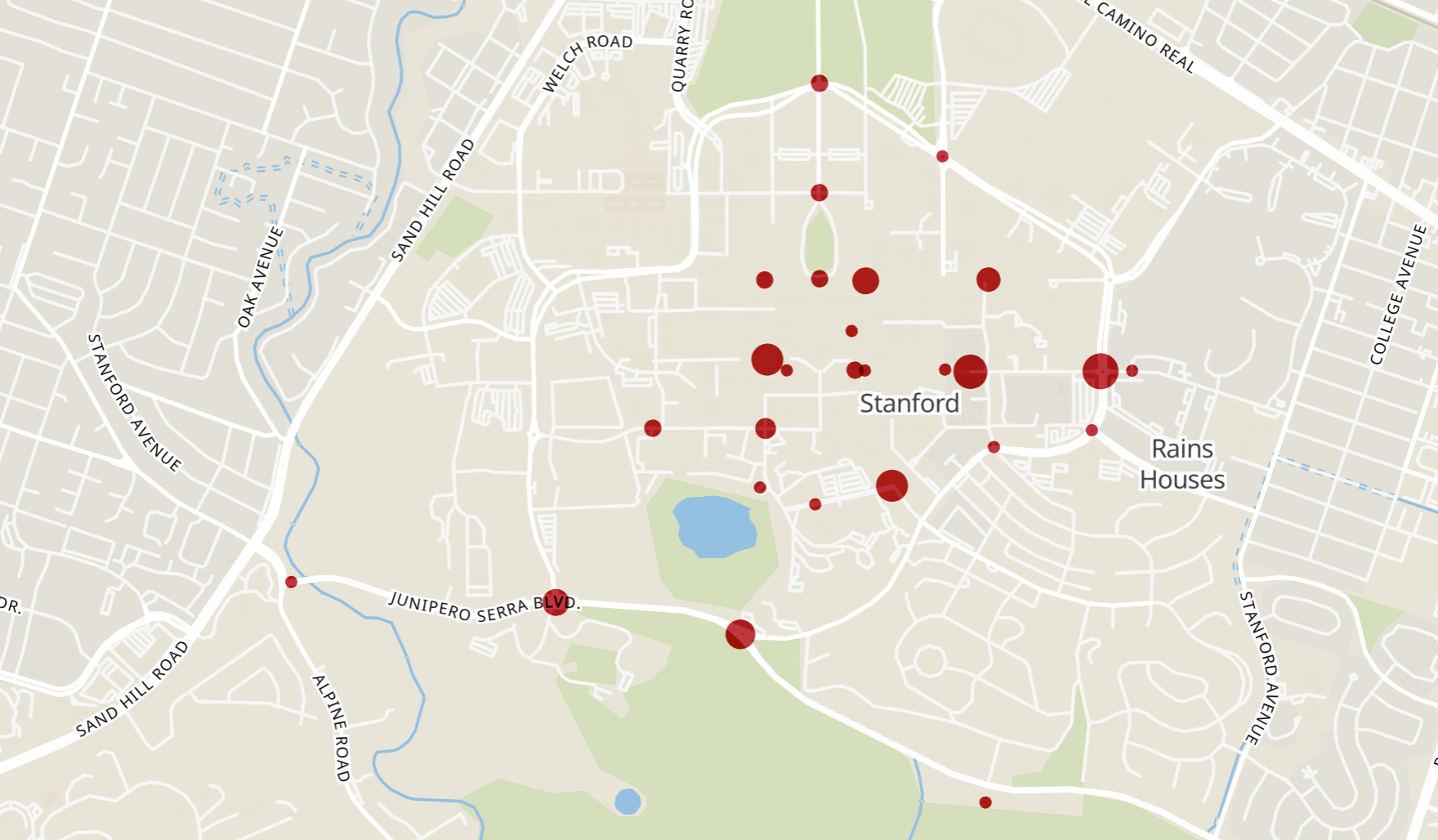Over 300 bike accidents were reported on campus between January 2014 and December 2018, according to a Daily analysis of data provided by the Stanford Department of Public Safety (SUDPS).
About 35% of the 307 accidents reported involved vehicles. Collisions with fixed objects ranked next, taking up about 20% of the total accidents. Thirteen cases involved collisions with live animals, broken branches, a basketball and a bag.
Forty-eight cases were investigated by the California Highway Patrol (CHP), whose jurisdiction covers the Stanford campus. Aside from investigating cases that occur along off campus streets like Junipero Serra Boulevard and Stanford Avenue, the Patrol conducts the investigation when an on-campus collision results in a major injury or transport to the Stanford hospital, said SUDPS spokesperson Bill Larson.
High-impact locations
Data shows that the “Circle of Death,” the roundabout next to the Clock Tower at the intersection of Lasuen Mall and Escondido Mall, may deserve its notoriety. Between January 2014 and December 2018, seven major bike accidents occurred around the “Circle of Death.”
However, data also shows that there are other locations with an equal or higher number of bike accidents reported to the SUDPS. For instance, nine or more bike accidents happened at four locations other than the “Circle of Death,” mostly at the intersections of major on-campus roads.
Among those locations, the intersection of Campus Drive and Escondido Road had the highest proportion of bike-vehicle collisions. According to the data, eight out of 11 major bike accidents occurred at the intersection involved collisions with a vehicle.
The intersection, which separates Casper Quad from Mirrielees, meets almost every condition for bike accidents. It has a high volume of traffic, moving students from their residences on east campus to their classes in the Main Quad and the Science and Engineering Quad on central and west campus. Bicycles exiting from the parking lot also overlapped with the already congested traffic on the intersection.
“[The situation at the intersection] was really bad,” said Kelly Rohlfs, a project manager at Stanford who has worked on road improvement projects on the Stanford campus since 1997.
To enhance traffic safety, Stanford put a roundabout at this intersection in September 2014, the first among many roundabouts constructed on campus. The team also put extra signs, lightings and crossings to improve traffic safety around the campus.
Stanford plans to build or renovate more roundabouts around the campus, targeting intersections with high traffic volume — including the “Circle of Death,” which Rohlfs hopes to renovate in Summer 2021. She believes installing additional safety facilities, such as “splinter islands,” that divide the roads and serve as pedestrian islands, will make the notorious intersection safer.
The blueprint of the “Circle of Death” after renovation.
Source: Kelly Rohlfs, Stanford University
Stanford’s growth makes such road improvements project an urgent issue. According to “Stanford Facts,” a white paper released by the University in 2019, the size of the student body and faculty grew about 16.5% between 2000 and 2018, adding another 3,000 people to campus.
“There are just more bicycles than there were in the past,” Rohlfs said.
Next academic year, Stanford may see another spike in population, as the newly renovated residential compound on the Escondido Village will accommodate about 2,400 graduate residents. The housing brings off-campus students onto east campus, but it may also increase traffic between the quads and the east campus.
Data shows that controlling the daytime traffic will be a major issue for traffic safety in the coming years. Most of the bike accidents reported to the SUDPS occurred during the daytime. The number of reported accidents spiked around 9 a.m., when most of the regular courses begin.
Because Stanford’s bicycle traffic is concentrated in the 10-minute intervals between classes, the campus “doesn’t look like anywhere else in the United States,” Rohlfs said.
“Between those 10-minute periods, bikes are just cramming into the roads and the intersections,” she added.
Marguerite buses on operation during the same hours can also jam the traffic along major campus roads, such as Jane Stanford Way and Santa Teresa Street. Rohlfs said bikers reluctant to share the roads put both the drivers and bikers at the risk of serious accidents.
Awareness is key
Enhancing traffic safety with road improvements has realistic restraints. Rohlfs’ team operates within the limited budget for common improvement projects, part of the Stanford Infrastructure Program (SIP), which consists of projects developed for the improvement of overall quality of campus environment. According to the Stanford Guide Memo, the size of the program’s funding is determined by the 4.6% assessment of “all expenditures within capital projects” at Stanford.
While her team’s effort can offset the increase in on-campus traffic, Rohlfs said people’s awareness of bike safety is key to prevent accidents.
“We need to change bicyclists’ behavior,” she said. “There’s nothing I can build any more.”
Larson also underscored the importance of bicyclists’ awareness.
“Bicyclists are required to obey the same traffic laws that apply to motorists such as stopping at stop signs and yielding to traffic in the roundabouts,” he wrote to The Daily.
Larson also emphasized the usage of lighting equipment, such as bicycle lights, during the nighttime.
“We highly recommend reflective attire and proper bicycle helmets which can save lives,” he wrote.
Matthew Early contributed reporting.
Contact Won-Gi Jung at jwongi ‘at’ stanford.edu.
